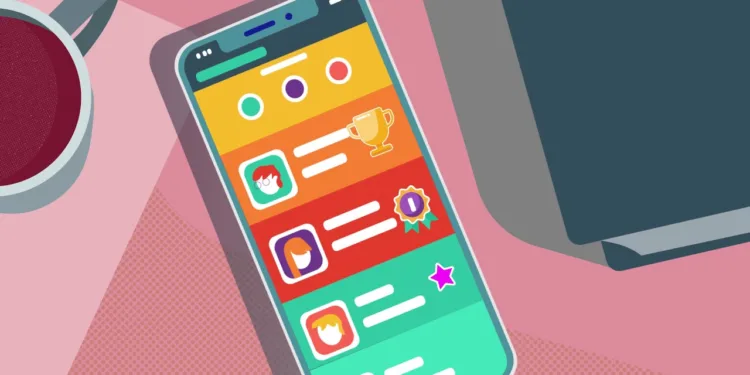In today’s mobile app ecosystem, it’s not enough to simply have a functional app. Users want an app that is engaging, interactive, and fun to use. This is where gamification comes in – the integration of game-like elements into non-game contexts, such as mobile apps. In this article, we will explore the role of gamification in mobile app design and engagement, and why it’s becoming increasingly popular among app developers.
The world of mobile apps is constantly evolving, with new trends and technologies emerging all the time. One such trend that has gained significant traction in recent years is gamification. By incorporating game-like features into non-game contexts, such as productivity apps or fitness trackers, app developers can make their apps more engaging and enjoyable for users.
The concept of gamification is not new. Games have always been an integral part of human culture, and we’ve been using game-like elements to motivate and engage people for centuries. In the digital age, however, the possibilities for gamification are endless. With mobile devices now ubiquitous, app developers are taking advantage of this trend to make their apps more appealing to users.
In this article, we will explore the role of gamification in mobile app design and engagement. We will look at the benefits of gamification, the different types of game-like elements that can be incorporated into apps, and some of the best practices for implementing gamification effectively.
Benefits of Gamification:

One of the primary benefits of gamification is that it can increase user engagement. By incorporating game-like features into an app, users are more likely to spend more time using the app and feel more motivated to achieve their goals. This, in turn, can lead to increased user retention, as users are more likely to return to an app that they find engaging.
Gamification can also make learning more fun and interactive. For example, language-learning apps can incorporate game-like features, such as rewards for completing lessons or achievements for mastering certain words or phrases. This can make the process of learning a new language feel less like a chore and more like a game.
Types of Game-like Elements:
There are many different types of game-like elements that can be incorporated into mobile apps. These include:
- Points and badges – Users can earn points or badges for completing certain tasks or achieving certain milestones within the app.
- Leaderboards – Users can see how they rank compared to other users of the app, which can create a sense of competition and motivate them to do better.
- Challenges – Users can be given challenges to complete within the app, such as completing a certain number of workouts or reaching a certain level of productivity.
- Rewards – Users can earn rewards for completing tasks within the app, such as unlocking new features or receiving discounts on products.
- Avatars – Users can create their own avatars to represent themselves within the app, which can add a personal touch and create a sense of ownership.

source: Google Images
Best Practices for Gamification:
While gamification can be a powerful tool for increasing user engagement, it’s important to use it effectively. Here are some best practices for incorporating game-like elements into mobile apps:
- Keep it simple – The game-like elements should be easy to understand and not detract from the core functionality of the app.
- Make it relevant – The game-like elements should be relevant to the app’s overall purpose and goals.
- Provide feedback – Users should receive feedback on their progress within the app, such as how many points they’ve earned or how close they are to completing a challenge.
- Balance the rewards – The rewards should be balanced so that they are not too difficult or too easy to achieve.
- Test and iterate – App developers should test the gamification features and iterate based on user feedback to ensure that they are effective.
Examples of Successful Gamification in Mobile Apps:
There are many examples of successful gamification in mobile apps. One of the most well-known is Duolingo, a language-learning app that uses gamification to make learning a new language more fun and engaging. Duolingo incorporates game-like elements such as points, badges, and challenges to motivate users to complete lessons and improve their language skills.

Another example is Fitbit, a fitness tracker app that uses gamification to encourage users to exercise more. Fitbit incorporates game-like elements such as challenges and rewards to motivate users to reach their fitness goals and stay active.
Finally, Habitica is an app that gamifies productivity. It turns your to-do list and daily tasks into a role-playing game, where completing tasks earns you points and unlocks rewards, such as new items for your virtual avatar or access to new game features.
Conclusion:
Gamification is becoming an increasingly popular trend in mobile app design and engagement. By incorporating game-like elements into non-game contexts, app developers can make their apps more engaging, interactive, and enjoyable for users. Motivational design can increase user engagement, make learning more fun, and provide motivation for users to achieve their goals.
When incorporating gamification into mobile apps, it’s important to keep it simple, make it relevant to the app’s overall purpose and goals, provide feedback, balance the rewards, and test and iterate based on user feedback. Successful examples of motivational design in mobile apps include Duolingo, Fitbit, and Habitica.
Overall, gamification is a powerful tool for increasing user engagement and should be considered by app developers looking to create a more engaging and enjoyable user experience.



















